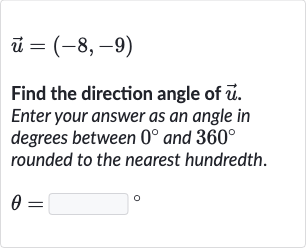Full solution
Q. Find the direction angle of . Enter your answer as an angle in degrees between and rounded to the nearest hundredth.
- Find direction angle of vector: To find the direction angle of the vector , we need to calculate the angle that this vector makes with the positive x-axis. The direction angle can be found using the arctangent function (also known as the inverse tangent or atan), which is the ratio of the y-coordinate to the x-coordinate of the vector.
- Calculate arctangent of ratio: First, we calculate the arctangent of the ratio of the y-coordinate to the x-coordinate of the vector . Since , we have:.
- Use calculator to find arctan: Using a calculator, we find that:.
- Adjust angle for correct quadrant: The of gives us an angle in the first quadrant, but since both the and components of the vector are negative, the vector is actually in the third quadrant. We need to add to the angle we get from the function to place it in the correct quadrant.
- Calculate final angle: Calculating the angle, we get:.
- Round angle to nearest hundredth: Using a calculator, we find that:.
- Round angle to nearest hundredth: Using a calculator, we find that:.Adding ° to .°, we get:.
- Round angle to nearest hundredth: Using a calculator, we find that:.Adding ° to .°, we get:.We round the angle to the nearest hundredth, as requested:.
More problems from Inverses of sin, cos, and tan: degrees
QuestionGet tutor help
QuestionGet tutor help
QuestionGet tutor help
QuestionGet tutor help
QuestionGet tutor help
QuestionGet tutor help
Question
. Find the value of in degrees.Write your answer in simplified, rationalized form. Do not round.____
Get tutor helpQuestionGet tutor help

